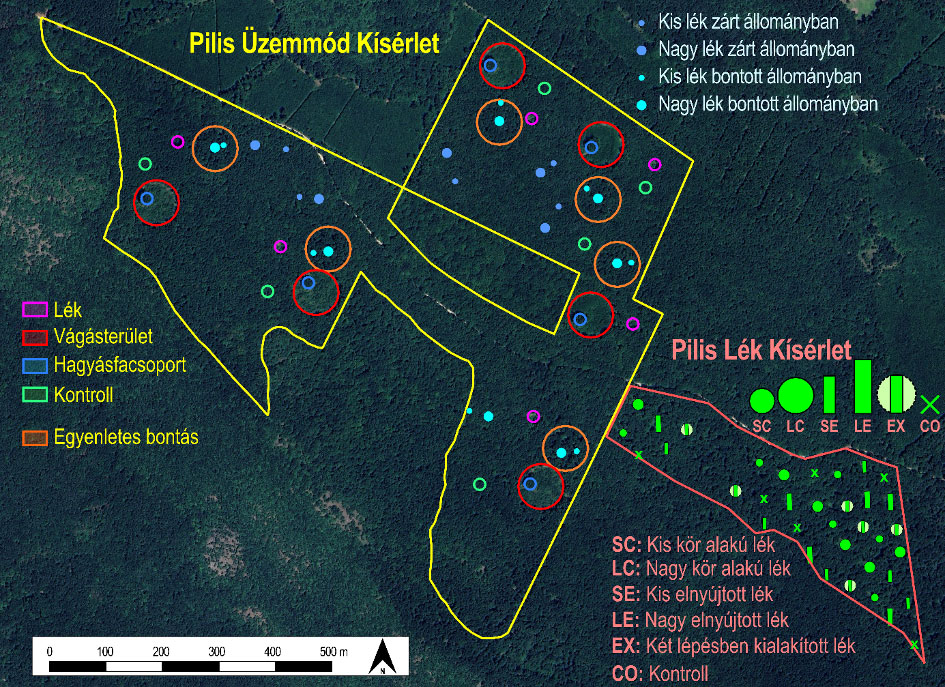Research infrastructure
Pilis Forestry Systems and Pilis Gap Experiments
Summary
Pilis Forestry Systems and Pilis Gap Experiments are two multi-taxon field experiments carried out in close cooperation between CER IEB and Pilis Parkerdő Forestry Ltd. The Pilis Forestry Systems Experiment compares the treatments of the shelterwood system (clear-cutting, retention tree group) and the most typical treatment under the framework of continuous cover forestry system (artificial gaps) with the closed stand. Gaps are investigated in both closed and thinned stands. The Pilis Gap Experiment focuses on specific forest characteristics and compares the processes taking place in artificial gaps of different shape (circular/elongated), size (150 m2/300 m2) and design (single step/multiple steps) with the closed stand as control. Each treatment was carried out in a complete block design, in six replicates. The experiments include continuous monitoring of soil and litter conditions, microclimate, community changes and regeneration of several groups of organisms (e.g. understory, Enchytraeids, ground beetles, spiders, soil microbiome), as well as measuring individual growth of tree seedlings. The experiments aim to provide scientific knowledge for the development of forestry practices that maintain forest biodiversity, natural regeneration of the main tree species, and management that mitigates the effects of climate change.

Related publications
Aszalós Réka; Kovács Bence; Tinya Flóra; Németh Csaba; Horváth Csenge Veronika; Ódor Péter. Canopy gaps are less susceptible to disturbance-related and invasive herbs than clear-cuts: Temporal changes in the understorey after experimental silvicultural treatments FOREST ECOLOGY AND MANAGEMENT, 549 Paper: 121438 (2023)
2023
Horváth Csenge Veronika; Kovács Bence; Tinya Flóra; Schadeck Locatelli Julia; Németh Csaba; Crecco Lorenzo; Illés Gábor; Csépányi Péter; Ódor Péter. A matter of size and shape: Microclimatic changes induced by experimental gap openings in a sessile oak–hornbeam forest SCIENCE OF THE TOTAL ENVIRONMENT, 873 Paper: 162302 (2023)
2023
Samu Ferenc; Elek Zoltán; Růžičková Jana; Botos Erika; Kovács Bence; Ódor Péter. Can Gap-Cutting Help to Preserve Forest Spider Communities? DIVERSITY-BASEL, 15 : 2 Paper: 240 (2023)
2023
Elek, Zoltán; Růžičková, Jana; Ódor, Péter. Functional plasticity of carabids can presume better the changes in community composition than taxon‐based descriptors ECOLOGICAL APPLICATIONS. 32: -
2022
Samu, Ferenc; Elek, Zoltán; Kovács, Bence; Fülöp, Dávid; Botos, Erika; Schmera, Dénes; Aszalós, Réka; Bidló, András; Németh, Csaba; Sass, Vivien; Tinya, Flóra; Ódor, Péter. Resilience of spider communities affected by a range of silvicultural treatments in a temperate deciduous forest stand SCIENTIFIC REPORTS. 11: -
2021
Kovács, Bence; Tinya, Flóra; Németh, Csaba; Ódor, Péter. Unfolding the effects of different forestry treatments on microclimate in oak forests: results of a 4-year experiment ECOLOGICAL APPLICATIONS. 30: -
2020
Tinya, Flóra; Kovács, Bence; Aszalós, Réka; Tóth, Bence; Csépányi, Péter; Németh, Csaba; Ódor, Péter. Initial regeneration success of tree species after different forestry treatments in a sessile oak-hornbeam forest FOREST ECOLOGY AND MANAGEMENT. 459: -
2020
Boros, Gergely; Kovács, Bence; Ódor, Péter. Green tree retention enhances negative short-term effects of clear-cutting on enchytraeid assemblages in a temperate forest APPLIED SOIL ECOLOGY. 136: 106-115
2019
Tinya, Flóra; Kovács, Bence; Prättälä, Aurora; Farkas, Péter; Aszalós, Réka; Ódor, Péter. Initial understory response to experimental silvicultural treatments in a temperate oak-dominated forest EUROPEAN JOURNAL OF FOREST RESEARCH. 138: 65-77
2019
Elek, Zoltán; Kovács, Bence; Aszalós, Réka; Boros, Gergely; Samu, Ferenc; Tinya, Flóra; Ódor, Péter. Taxon-specific responses to different forestry treatments in a temperate forest SCIENTIFIC REPORTS. 8: Paper 16990-
2018


